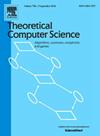三维混合可编程物质的高效形状形成:一种小直径中间结构的算法
IF 1
4区 计算机科学
Q3 COMPUTER SCIENCE, THEORY & METHODS
引用次数: 0
摘要
本文考虑了三维混合模型中的形状形成问题,其中单个代理具有严格限制的观察范围和确定性有限自动机的计算能力,通过拾取,移动和放置动作来操纵被动瓷砖。目标是将一组瓷砖重新配置成一种特定的形状,称为冰柱。冰柱被认为是一种致密、无孔的结构,被策略性地选择为更复杂的形状形成任务的中间形状。它的设计是为了方便有限状态代理的探索,使识别可以在不破坏连接的情况下抬起的瓷砖。与线形相比,冰柱具有明显的优点,包括直径减小和多个可拆卸瓦片的存在。我们提出了一种算法,该算法在O(n3)步中将任意初始连接的瓦片结构转换为冰柱,与先前工作中的线形成算法的运行时间相匹配。我们的理论贡献伴随着广泛的实验分析,表明我们的算法平均减少了瓦片结构的直径。本文章由计算机程序翻译,如有差异,请以英文原文为准。
Efficient shape formation by 3D hybrid programmable matter: An algorithm for low diameter intermediate structures
This paper considers the shape formation problem within the 3D hybrid model, where a single agent with a strictly limited viewing range and the computational capacity of a deterministic finite automaton manipulates passive tiles through pickup, movement, and placement actions. The goal is to reconfigure a set of tiles into a specific shape termed an icicle. The icicle, identified as a dense, hole-free structure, is strategically chosen to function as an intermediate shape for more intricate shape formation tasks. It is designed for easy exploration by a finite-state agent, enabling the identification of tiles that can be lifted without breaking connectivity. Compared to the line shape, the icicle presents distinct advantages, including a reduced diameter and the presence of multiple removable tiles. We propose an algorithm that transforms an arbitrary initially connected tile structure into an icicle in steps, matching the runtime of the line formation algorithm from prior work. Our theoretical contribution is accompanied by an extensive experimental analysis, indicating that our algorithm decreases the diameter of tile structures on average.
求助全文
通过发布文献求助,成功后即可免费获取论文全文。
去求助
来源期刊

Theoretical Computer Science
工程技术-计算机:理论方法
CiteScore
2.60
自引率
18.20%
发文量
471
审稿时长
12.6 months
期刊介绍:
Theoretical Computer Science is mathematical and abstract in spirit, but it derives its motivation from practical and everyday computation. Its aim is to understand the nature of computation and, as a consequence of this understanding, provide more efficient methodologies. All papers introducing or studying mathematical, logic and formal concepts and methods are welcome, provided that their motivation is clearly drawn from the field of computing.
 求助内容:
求助内容: 应助结果提醒方式:
应助结果提醒方式:


